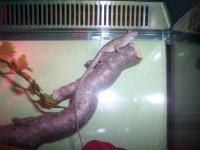Housing & Substrate:
The minimum enclosure for one Brown Anole is a ten gallon aquarium. They can not be housed in a plastic, cardboard, or wooden box. Add ten gallons per every extra Anole. Appropriate substrates include; reptile carpet, newspaper, paper towels, compressed coconut fiber, shelf liner, and tile.
Humidity & Water:
The humidity can be maintained by misting the enclosure at least 3 times daily, providing a reptile fogger, reptile mister, or water drop mechanism. The ideal humidity should be kept between 70% and 80% to low or two high can cause medical problems. Do not let the humidity fall below 60 or be over 80. Your Anole will drink up the droplets left on the leaves and decorations in the enclosure after misting. You also need to provide a small water dish for drinking and bathing. Replace the water daily.
Temperature & Lighting:
The enclosure needs to be kept between 75˙F (24˙C) and 80˙F (27˙C) during the day and between 70˙F (21˙C) and 75˙F (24˙C) at night and a basking temperature (near the heat light) of 90˙F (32˙C). Like with all other diurnal (awake during the day) lizards. They will need a UVB producing light. This light needs to be on for 10-12 hours a day. During this time, the light will provide enough UV rays for proper digestion and release appropriate amounts of vitamin D3 to allow for calcium absorption. Without a UVB light it is extremely likely for your pet to get a medical condition called MBD. This stands for Metabolic Bone Disease which is fatal if not caught early enough.
Feeding & Supplements:
Juveniles and adults can eat a staple of crickets (no bigger then the space between their eyes) with a variety of butter worms, super worms, and silk worms. Adults and juveniles need to be fed daily. Dust the crickets and other food items with a calcium/multivitamin supplement. This is crucial to your pet’s health and needs to be done to all food items every other feeding. Dust the insects with a calcium/D3 supplement at least once a month.
Gender:
Most females will have a diamond pattern down their spine that is all lined up. Males will have a colorful dewlap (flap of skin under the chin that expands to look like they are puffing their throat) this is extended to show threatening behavior and its also used as a demonstration to attract mates. Females can have dewlaps as well but never as big or as colorful. There will also be two enlarged scales on the underside of the males near the vent area.
Shopping List / Minimum Requirements:
An enclosure as mentioned above with a screen lid
Plenty of fake or real plants and branches logs and other items to climb on
A UVB producing fluorescent light
A heat lamp, or a ceramic heat emitter (this basking light should be outside of the enclosure so the Anole does not get burned)
A digital Hygrometer (humidity gauge)
A digital Thermometer (the stick on plastic dials can be up to 20 degrees inaccurate )
A reptile mister (spray/mist bottle for water) or a water drip mechanism
A small water dish
Substrate (above)
A nocturnal /red heat bulb or a ceramic heat emitter to maintain night time temperatures
Not Appropriate:
There are many items that Anoles should not have. Heat Rocks and Heat Caves can severely burn your lizard’s stomach and feet and should be avoided for all lizards. The only advantage to using a Heat Pad is to keep the substrate warm for humidity purposes they use over head heat not ground heat to stay warm. Do not use any Sand, Gravel, or Repti-Bark substrates. Do not feed mealworms, their hard exoskeleton can easily cause impaction they are also very low in nutrients and aren’t healthy for your pet.
Other Information:
Males can reach 7 - 9 inches with females reaching about 6 inches in length and usually live 3-5 years if taken care of properly.
These anoles are very fast and are hard to catch. They should not be handled and aren’t for young kids. They don’t play and should remain in their enclosure unless its time to clean it out.


